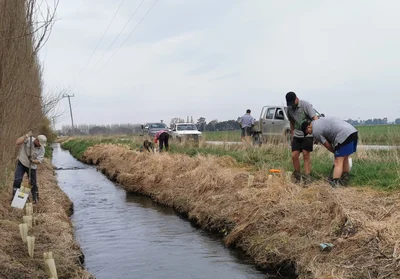Lowlands catchment group

In 2013 the Ashburton Zone Committee tasked the Hinds Drain Working Party to develop, with the community, a set of recommendations to manage water quality and quantity in the Hinds Catchment.
The working group, which included membership from the local community, Ashburton Water Zone Committee, Arowhenua Runanga, Forest & Bird, Fish & Game and the Department of Conservation presented 16 recommendations targeted at “improving the health of the water bodies of Lower Hinds for all.”
While many of the recommendations are underway, five years ago a group of younger farmers around the Eiffelton area started a small catchment group.
More recently this has been expanded to encompass an area from the Rangitata River to the Ashburton River, east of State Highway 1.
The Hekeao Hinds Lowlands Catchment Group now has 33 active members.
We’ve been focused on how we can further enhance the quality of water and life in our drains.
This catchment is already part of an extensive water testing programme run by MHV Water.
The catchment group expanded that by testing further to build knowledge of levels of nitrate in drains and tiles.
Members have adopted many on-farm mitigations which enhance drain water quality from recommendations made by the Hinds Drains Working Party.
These include stock exclusion, cultivation setback areas and fertiliser placement away from waterways and these mitigations will continue to develop.
To learn more, the catchment group “adopted” one drain, Windemere Drain, where we can trial different techniques to further enhance the environment in the drains.
With assistance from Fish & Game officer, Mark Webb, over 20 rock weirs were installed.
This had an immediate impact of creating pools and fast flowing shallow water to provide an improved environment for instream habitat such as fish and invertebrates.
Shade and cover were other factors thought to be important.
The catchment group planted more than 2500 native grasses over two years, supplied by Synlait’s Whakapuawai Project.
These are now establishing, and the area is providing cover for species along the drain edge. With assistance from Fish & Game, we continue to monitor the number and size of species in the waterway to show what impact these enhancements have made. This is a long term project, but early signs are extremely promising.
Our catchment group has other projects underway to look at how we can continue to enhance the health of our lowlands streams and drains.
We are currently partnering with MPI/MfE and Canterbury University, and other community contributors, to evaluate a prototype biodigester.
The digester uses existing bacteria from the environment to “eat up” the nitrate in the water and release “cleaner” water into the drain.
This is an exciting initiative and our catchment group will hopefully have more to report over the next two years.
By Lowlands Catchment Group Facilitator Phill Everest
